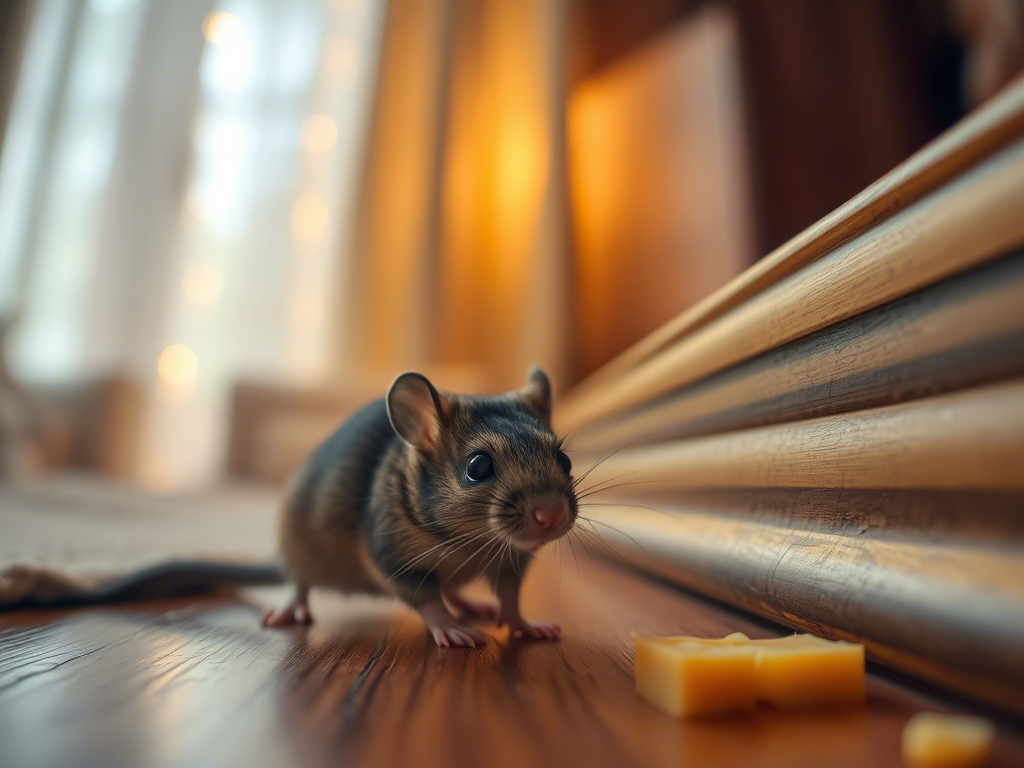Mice infestations can be a frustrating and potentially dangerous problem for homeowners. Not only do mice damage property by gnawing through walls, wires, and furniture, but they also pose serious health risks by spreading diseases and contaminating food sources. If you’re dealing with an unwanted mouse presence in your home or business, it’s crucial to act quickly and effectively.
This comprehensive guide will walk you through proven methods on how to get rid of mice , including prevention strategies, humane removal options, and professional extermination techniques. Whether you’re facing a minor mouse issue or a full-blown infestation, this article will provide you with all the tools and knowledge needed to reclaim your space safely and efficiently.
Step 1: Identify Signs of Mouse Infestation
Before implementing any solution, it’s essential to confirm that you are indeed dealing with mice. Here are common signs to look for:
- Droppings : Small, dark, rice-like droppings near cabinets, drawers, or corners.
- Gnaw Marks : Fresh chew marks on wood, plastic, or food packaging.
- Nesting Materials : Shredded paper, fabric, or insulation found in secluded areas like attics or basements.
- Noises : Scratching or scurrying sounds in walls, especially at night.
- Grease Marks : Oily rub marks along walls where mice frequently travel.
If you observe any of these signs, it’s time to take action.
Step 2: Seal Entry Points to Prevent Future Infestations
One of the most effective ways to get rid of mice permanently is to prevent them from entering your home in the first place. Mice can squeeze through openings as small as a dime, so thorough inspection is key.
How to Seal Entry Points:
- Inspect the Exterior : Walk around your home and check for cracks in the foundation, gaps around pipes, vents, windows, and doors.
- Use Steel Wool and Caulk : Stuff steel wool into small holes and seal with caulk. Mice cannot chew through steel wool.
- Install Door Sweeps : Add door sweeps to exterior doors to eliminate gaps at the bottom.
- Repair Damaged Screens : Replace torn window screens or damaged vents.
- Check Utility Openings : Sealing spaces around electrical wires, plumbing, and HVAC systems is critical.
For more information on identifying and sealing entry points, visit PestWorld.org , a trusted resource on pest control and prevention.
Step 3: Remove Food Sources
Mice are attracted to homes primarily because of available food. Eliminating their food supply is a crucial step in getting rid of them.
Tips to Eliminate Food Sources:
- Store Food Properly : Use airtight containers for grains, cereals, pet food, and other dry goods.
- Clean Regularly : Wipe down counters, sweep floors, and vacuum regularly to remove crumbs and food particles.
- Dispose of Garbage Promptly : Keep trash bins tightly sealed and empty them frequently.
- Avoid Leaving Pet Food Out Overnight : Feed pets during the day and remove bowls at night.
By removing easy access to food, you’ll make your home far less appealing to mice.
Step 4: Set Traps – Choose the Right Type for Your Situation
Trapping is one of the most popular and effective methods to get rid of mice . There are several types of traps available, each with its own advantages.
Common Types of Mouse Traps:
- Snap Traps : Traditional and highly effective, snap traps kill mice instantly when triggered.
- Live Catch Traps : Ideal if you prefer to release the mice outdoors. Make sure to release them at least 2–3 miles away to prevent return.
- Glue Traps : These are controversial due to animal cruelty concerns and are not recommended by many experts.
- Electronic Traps : These deliver a quick electric shock, killing mice humanely and allowing for easy disposal.
Tips for Effective Trapping:
- Bait Smartly : Peanut butter, chocolate, oatmeal, or nesting materials (like cotton balls) work well as bait.
- Place Strategically : Set traps along walls, behind appliances, and near known mouse activity.
- Check Daily : Check traps every morning and evening, and dispose of dead mice promptly while wearing gloves.
For detailed instructions on setting up different types of traps, visit Orkin.com , a leading pest control service provider.
Step 5: Use Natural Repellents and Deterrents
If you’re looking for non-lethal or chemical-free solutions, natural repellents can help deter mice from staying in your home.
Effective Natural Mouse Repellents:
- Peppermint Oil : Soak cotton balls in peppermint oil and place them near entry points or nests. Mice dislike the strong scent.
- Cayenne Pepper : Sprinkle cayenne pepper or chili powder in corners and cupboards.
- Ultrasonic Devices : These emit high-frequency sound waves that are unpleasant to mice but safe for humans and pets.
- Predator Scents : Products containing predator urine (like fox or cat urine) can scare mice away.
While natural deterrents can help, they should be used in conjunction with other methods for best results.
Step 6: Clean and Sanitize After Infestation
Once you’ve successfully removed the mice, it’s vital to clean and sanitize the affected areas to prevent disease spread and discourage future infestations.
Steps to Clean Up Safely:
- Wear Protective Gear : Gloves and masks are necessary to avoid exposure to harmful pathogens.
- Spray Surfaces with Disinfectant : Use a bleach solution (1 part bleach to 9 parts water) or commercial disinfectant to kill bacteria.
- Vacuum Thoroughly : Vacuum droppings and nesting materials carefully, then dispose of the vacuum bag immediately.
- Wash Linens and Fabrics : Any bedding, curtains, or clothing that may have come into contact with mice should be washed in hot water.
Proper cleaning not only eliminates lingering odors that attract more mice but also ensures a healthier living environment.
Step 7: Consider Using Rodenticides (With Caution)
Rodenticides, or mouse poisons, are chemical baits designed to kill rodents. While effective, they come with risks such as secondary poisoning in pets or wildlife.
When to Use Rodenticides:
- For severe infestations where trapping alone isn’t enough.
- In inaccessible areas where mice hide and breed.
Important Safety Tips:
- Place in Secure Bait Stations : This prevents children and pets from accessing the poison.
- Monitor Regularly : Dead mice inside walls can cause odor problems and attract other pests.
- Follow Label Instructions Carefully : Misuse can lead to legal and environmental issues.
If you’re unsure about using rodenticides, consult a licensed pest control professional.
Step 8: Call in the Professionals for Severe Infestations
Sometimes, DIY methods aren’t sufficient, especially when dealing with large-scale or recurring infestations. Professional exterminators have the expertise, tools, and experience to handle even the most stubborn mouse problems.
Benefits of Hiring a Pest Control Service:
- Comprehensive Inspection : Identifies all possible entry points and nesting sites.
- Customized Treatment Plans : Tailored to your specific situation and home layout.
- Guaranteed Results : Most services offer follow-up visits and warranties.
- Safe and Legal Methods : Ensures compliance with local regulations and safety standards.
To find a certified pest control expert in your area, visit National Pest Management Association .
Step 9: Maintain Long-Term Prevention Strategies
Getting rid of mice is only half the battle. To keep them from returning, implement long-term preventive measures.
Mouse Prevention Checklist:
- ✅ Seal all potential entry points.
- ✅ Store food in secure containers.
- ✅ Keep your home clutter-free to eliminate hiding spots.
- ✅ Conduct seasonal inspections for wear and tear.
- ✅ Use natural repellents or motion-activated lights outdoors.
Consistent maintenance is key to ensuring a mouse-free home year-round.
Step 10: Educate Yourself and Stay Vigilant
Knowledge is power when it comes to pest control. Staying informed about mouse behavior, new products, and best practices helps you stay ahead of potential infestations.
Subscribe to newsletters or blogs like TheHowToTips.com for the latest guides, reviews, and tips on how to tackle household pests effectively.
Conclusion
Dealing with mice doesn’t have to be overwhelming. By following this step-by-step guide, you can confidently tackle a mouse infestation using a combination of prevention, trapping, cleaning, and professional assistance when needed.
Remember, early detection and consistent maintenance are crucial in keeping your home mouse-free. Don’t wait until the problem gets worse—act now and protect your space from these persistent pests.
Frequently Asked Questions (FAQ)
Q1: What smells keep mice away?
A: Peppermint oil, cinnamon, vinegar, and clove oil are known to repel mice due to their strong scents.
Q2: Can mice climb walls?
A: Yes, mice are excellent climbers and can scale vertical surfaces like walls and trees.
Q3: Are mice active during the day?
A: While primarily nocturnal, mice may venture out during the day if food is scarce or if there’s a large population.
Q4: How fast do mice reproduce?
A: Female mice can give birth every 3 weeks, with litters averaging 6–8 pups. This rapid reproduction makes prompt action essential.
Q5: Do ultrasonic mouse repellents work?
A: Some studies suggest they may provide temporary relief, but they are not a standalone solution and work best with other methods.
Q6: How long can a mouse live in a house?
A: On average, mice live about 12 months indoors, though they typically die from traps, poison, or predators before reaching that age.
Q7: Can mice get through concrete?
A: Mice cannot chew through solid concrete, but they can exploit cracks or gaps in concrete structures.
Q8: Should I throw out food after mice?
A: Yes, any food that may have been contaminated by mice should be discarded to avoid health risks.
Q9: What time of year do mice come inside?
A: Mice often seek shelter indoors during colder months, typically from late fall through winter.
Q10: Can mice survive in a house without food?
A: Mice need to eat constantly and cannot survive for more than a few days without food.
For more helpful tips and guides on pest control, home improvement, and everyday life hacks, visit TheHowToTips.com . Stay proactive, stay informed, and enjoy a pest-free living environment!

